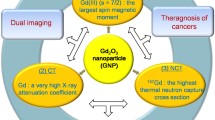Abstract
Nanoparticles (NPs) are useful for radiotherapy. Currently, efforts are underway globally for the development of novel titanium dioxide NPs (TiO2-NPs) that exhibit both contrast effects and anti-tumor effects. In this study, the image contrast properties of TiO2-NPs were evaluated using a clinical magnetic resonance imaging (MRI) system and a clinical computed tomography (CT) scanner, as the use of TiO2-NPs as an anti-cancer agent has been reported in several reports. An obvious difference in visualization was observed between the control and TiO2-NP samples on T2-weighted images. These results suggest that TiO2 can potentially be used as a novel theranostic drug with radiosensitizing ability and radiological diagnostic ability, through modification of chemical groups on its surface, and as a component of drug delivery systems.




Similar content being viewed by others
References
Akasaka H, Sasaki R, Miyawaki D, Mukumoto N, Sulaiman NS, Nagata M, Yamada S, Murakami M, Demizu Y, Fukumoto T (2014) Preclinical evaluation of bioabsorbable polyglycolic acid spacer for particle therapy. Int J Radiat Oncol Biol Phys 90(5):1177–1785. https://doi.org/10.1016/j.ijrobp.2014.07.048
Akasaka H, Mizushina Y, Yoshida K, Ejima Y, Mukumoto N, Wang T, Inubushi S, Nakayama M, Wakahara Y, Sasaki R (2016) MGDG extracted from spinach enhances the cytotoxicity of radiation in pancreatic cancer cells. Radiat Oncol 11(1):153
Allison RR, Bagnato VS, Sibata CH (2010) Future of oncologic photodynamic therapy. Future Oncol 6(6):929–940
Azizian G, Riyahi-Alam N, Haghgoo S, Moghimi HR, Zohdiaghdam R, Rafiei B, Gorji E (2012) Synthesis route and three different core-shell impacts on magnetic characterization of gadolinium oxide-based nanoparticles as new contrast agents for molecular magnetic resonance imaging. Nanoscale Res Lett 7(1):549
Babaei M, Ganjalikhani M (2014) The potential effectiveness of nanoparticles as radio sensitizers for radiotherapy. Bioimpacts 4(1):15
Bernard BK, Osheroff MR, Hofmann A, Mennear JH (1990) Toxicology and carcinogenesis studies of dietary titanium dioxide-coated mica in male and female Fischer 344 rats. J Toxicol Environ Health 29(4):417–429
Bischoff F, Bryson G (1982) Tissue reaction to and fate of par-enterally administered titanium dioxide. I. The intraperitoneal site in male Marsh-Buffalo mice. Res Commun Chem Pathol Pharmacol 38(2):279–290
Bump EA, Hoffman SJ, Foye WO, Abraham DJ (2003) Radiosensitizers and radioprotective agents. In: Abraham DJ (ed) Chemotherapeutic drugs, Burger’s medicinal chemistry and drug discovery, vol 5. Wiley, New York, pp 151–211
Chatterjee DK, Fong LS, Zhang Y (2008) Nanoparticles in photodynamic therapy: an emerging paradigm. Adv Drug Deliv Rev 60(15):1627–1637
Fabian E, Landsiedel R, Ma-Hock L, Wiench K, Wohlleben W, van Ravenzwaay B (2008) Tissue distribution and toxicity of intravenously administered titanium dioxide nanoparticles in rats. Arch Toxicol 82(3):151–157
Fang C, Zhang M (2009) Multifunctional magnetic nanoparticles for medical imaging applications. J Mater Chem 19(35):6258–6266
Garnica-Garza HM (2009) Contrast-enhanced radiotherapy: feasibility and characteristics of the physical absorbed dose distribution for deep-seated tumors. Phys Med Biol 54(18):5411–5425
Hainfeld JF, Slatkin DN, Focella TM, Smilowitz HM (2006) Gold nanoparticles: a new X-ray contrast agent. Br J Radiol 79(939):248–253
Huo S, Ma H, Huang K, Liu J, Wei T, Jin S, Zhang J, He S, Liang XJ (2013) Superior penetration and retention behavior of 50 nm gold nanoparticles in tumors. Cancer Res 73(1):319–330
Jin C, Tang Y, Yang FG, Li XL, Xu S, Fan XY, Huang YY, Yang YJ (2011) Cellular toxicity of TiO2 nanoparticles in anatase and rutile crystal phase. Biol Trace Elem Res 141(1–3):3–15
Kim BY, Rutka JT, Chan WC (2010) Nanomedicine. N Engl J Med 363(25):2434–2443
Kim D, Yu MK, Lee TS, Park JJ, Jeong YY, Jon S (2011) Amphiphilic polymer-coated hybrid nanoparticles as CT/MRI dual contrast agents. Nanotechnology 22(15):155101
Leon S, Zdenka K, Kostya O, Shailesh K (2012) Nanoparticles in cancer imaging and therapy. J Nanomater 2012, Article ID 891318
Maeda H, Wu J, Sawa T, Matsumura Y, Hori K (2000) Tumor vascular permeability and the EPR effect in macromolecular therapeutics: a review. J Control Release 65(1–2):271–284
Nakayama M, Sasaki R, Ogino C, Tanaka T, Morita K, Umetsu M, Ohara S, Tan Z, Nishimura Y, Akasaka H, Sato K, Numako C, Takami S, Kondo A (2016) Titanium peroxide nanoparticles enhanced cytotoxic effects of X-ray irradiation against pancreatic cancer model through reactive oxygen species generation in vitro and in vivo. Radiat Oncol 11(1):91
Perrault SD, Walkey C, Jennings T, Fischer HC, Chan WC (2009) Mediating tumor targeting efficiency of nanoparticles through design. Nano Lett 9(5):1909–1915
Ruba T, Tamilselvi R (2018) Radiosensitizers and radioprotectors for effective radiation therapy—a review. Asian J Appl Sci Eng 2(1):77–86
Service RF (2005) Materials and biology: nanotechnology takes aim at cancer. Science 310(5751):1132–1134
Srivastava SK, Yamada R, Ogino C, Kondo A (2013) Biogenic synthesis and characterization of gold nanoparticles by Escherichia coli K12 and its heterogeneous catalysis in degradation of 4-nitrophenol. Nanoscale Res Lett 8(1):70
Townley HE, Kim J, Dobson PJ (2012) In vivo demonstration of enhanced radiotherapy using rare earth doped titania nanoparticles. Nanoscale 4(16):5043–5050
Wilson BC, Patterson MS (2008) The physics, biophysics, and technology of photodynamic therapy. Phy Med Biol 53(9):R61–R109
Yamaguchi S, Kobayashi H, Narita T, Kanehira K, Sonezaki S, Kubota Y, Terasaka S, Iwasaki Y (2010) Novel photodynamic therapy using water-dispersed TiO2 polyethylene glycol compound: evaluation of antitumor effect on glioma cells and spheroids in vitro. Photochem Photobiol 86(4):964–971
Yezhelyev MV, Gao X, Xing Y, Al-Hajj A, Nie S, O’Regan RM (2006) Emerging use of nanoparticles in diagnosis and treatment of breast cancer. Lancet Oncol 7(8):657–667
Yin JJ, Liu J, Ehrenshaft M, Roberts JE, Fu PP, Mason RP, Zhao B (2012) Phototoxicity of nano titanium dioxides in HaCaT keratinocytes—generation of reactive oxygen species and cell damage. Toxicol Appl Pharmacol 263(1):81–88
Author information
Authors and Affiliations
Corresponding author
Additional information
Publisher's Note
Springer Nature remains neutral with regard to jurisdictional claims in published maps and institutional affiliations.
Rights and permissions
About this article
Cite this article
Akasaka, H., Mukumoto, N., Nakayama, M. et al. Investigation of the potential of using TiO2 nanoparticles as a contrast agent in computed tomography and magnetic resonance imaging. Appl Nanosci 10, 3143–3148 (2020). https://doi.org/10.1007/s13204-019-01098-y
Received:
Accepted:
Published:
Issue Date:
DOI: https://doi.org/10.1007/s13204-019-01098-y




